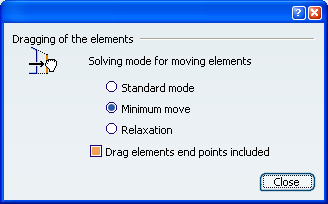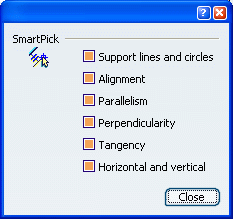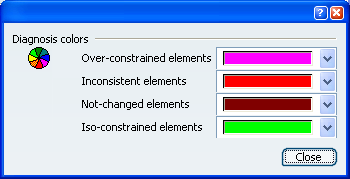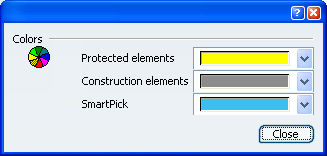Sketcher | ||
| ||
Grid
This section describes the various options available in the Grid area.

Snap to point
Defines whether annotations are snapped to the grid point.
![]() By default, this option is selected.
By default, this option is selected.
Allow Distortions
Defines whether grid spacing and graduations are the same horizontally and vertically.
![]() By default, this option is not selected.
By default, this option is not selected.
![]()
Sketch Plane
This section describes the various options available in the Sketch Plane area.

Shade sketch plane
Defines whether a shaded plane is displayed in the Sketcher workbench representing the sketch plane.
![]() By default, this option is not selected.
By default, this option is not selected.
![]()
Geometry
This section describes the various options available in the Geometry area.

Create circle and ellipse centers
Defines when you create a circle or an ellipse whether its center is created.
![]() By default, this option is selected.
By default, this option is selected.
Allow direct manipulation
Defines whether you are able to move geometry using the mouse according to the Solving Mode options.
![]() By default, this option is selected.
By default, this option is selected.
Solving Mode...
Click this button to display the solving mode options. 
Solving mode for moving elements:
Select one of the three following options:
- Standard mode: Specifies that you can move as many elements as possible with respect of existing constraints.
- Minimum move: Specifies that you can move as few elements as possible with respect of existing constraints.
- Relaxation: Specifies that you can move elements by re-distributing them over the sketch, globally speaking. This method solves element moving by minimizing energy cost.
![]() By default, Minimum Move is selected.
By default, Minimum Move is selected.
Drag elements end points included: Defines whether you move geometrical elements with their end points.
![]() By default, this option is selected.
By default, this option is selected.
![]()
Constraint
This section describes the various options available in the Constraint area.

Creates the geometrical constraints
Defines whether the geometrical constraints detected by the
SmartPick tool are created. This option is also available in the
Sketcher Tools toolbar through the Geometrical
Constraints capability
![]() .
.
![]() By default, this option is selected.
By default, this option is selected.
Creates the dimensional constraints
Defines whether the dimensional constraints detected by the
SmartPick tool are created. For more information, see SmartPick.
This option is also available in the Sketcher Tools
toolbar through the Dimensional Constraints capability ![]() .
.
![]() By default, this option is selected.
By default, this option is selected.
SmartPick...
Click this button to display the SmartPick options. The SmartPick detects multiple directions and positions, and more and more relationships with existing elements. This may lead to confusion due to the rapid highlighting of several different detection possibilities as you point the cursor at different elements in rapid succession.
Support lines and circles
Defines whether the line and arc of circle support are detected.
Alignment
Defines whether alignment constraint is detected.
Parallelism
Defines whether parallelism constraint is detected.
Perpendicularity
Defines whether perpendicularity constraint is detected.
Tangency
Defines whether tangency constraint is detected.
Horizontal and vertical
Defines whether horizontal and vertical constraints are detected.
![]() By default, all these options are selected.
By default, all these options are selected.
![]()
Colors
This section describes the various options available in the Colors area.

Default color of the elements
Defines the color of the geometrical elements.
![]() By default, the color is white. See the screen capture.
By default, the color is white. See the screen capture.
Visualization of diagnosis
Defines whether the diagnosis colors are applied. See Colors diagnoses.
![]() By default, this option is selected.
By default, this option is selected.
Colors...
Click this button to display diagnosis colors options.
Over-constrained elements
Defines the color of over-constrained elements.
![]() By default, the color is magenta as shown by the screen capture.
By default, the color is magenta as shown by the screen capture.
Inconsistent elements
Defines the color of inconsistent elements.
![]() By default, the color is red as shown by the screen capture.
By default, the color is red as shown by the screen capture.
Not-changed elements
Defines the color of unchanged elements.
![]() By default, the color is brown
as shown by the screen capture.
By default, the color is brown
as shown by the screen capture.
Iso-constrained elements
Defines the color of iso-constrained elements.
![]() By default, the color is green
as shown by the screen capture.
By default, the color is green
as shown by the screen capture.
Other color of the elements
Defines the color of the elements which are different of geometrical and diagnosis elements. See Colors for other elements.
Colors...
Click this button to display colors for other elements options.
Protected elements
Defines the color of the protected elements.
![]() By default, the color is yellow as shown by the screen capture.
By default, the color is yellow as shown by the screen capture.
Construction elements
Defines the color of construction elements.
![]() By default, the color is grey as shown by the screen capture.
By default, the color is grey as shown by the screen capture.
SmartPick
Defines the color of the SmartPick assistant elements and symbols.
![]() By default, the color is blue
as shown by the screen capture.
By default, the color is blue
as shown by the screen capture.
